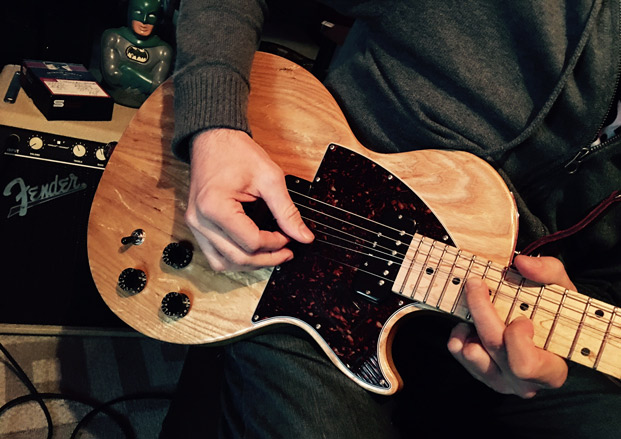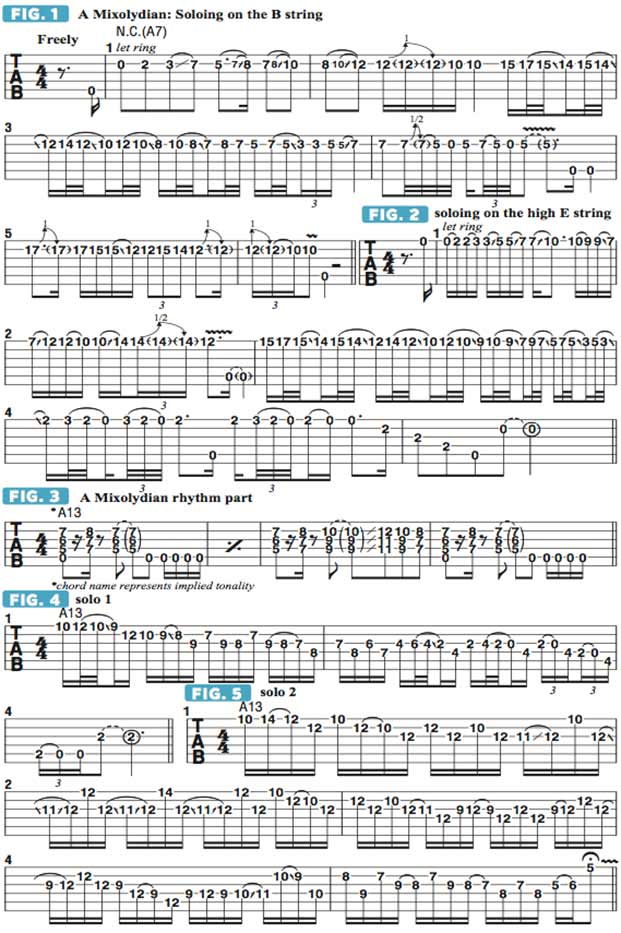Exploring Mixolydian-Based Melodies and Chord Structures

In the last few columns, we looked at ways to build chord shapes, or “grips,” from the Dorian and Aeolian modes (Aeolian is also known as the natural minor scale), which are two of the most widely used minor modes for soloing in rock, blues, and jazz.
Last month, we turned our attention to the equally popular and useful Mixolydian mode, which is intervallically spelled 1(root) 2 3 4 5 6 b7. This is the mode that includes the dominant-seven chord tones 1, 3, 5 and b7 and gives us chords like E7, A7 and D7, as well as chords that include “upper-structure tension tones,” or “tensions,” namely the ninth, 11th and 13th.
I encourage all guitarists to attain as complete an understanding of the Mixolydian mode as possible, as this will help in broadening one’s understanding of music theory and the fretboard, as well as reap countless options that can be applied to both soloing and rhythm guitar playing.
Last month’s column wrapped up with a look at some soloing examples based on A Mixolydian and played on the D and G strings. Let’s continue with soloing examples, as played on the B string over a ringing open A-string pedal tone, as illustrated in FIGURE 1.
Starting on beat four of bar 2, I begin a steadily descending line based on a recurring pull-off/slide motif, performed using a combination of 16th- and 32nd-note rhythms. Once you have this line under your fingers, try inventing some licks of your own that ascend and descend in a similarly “free” manner. Now let’s move this idea over to the high E string, as shown in FIGURE 2. Here, I begin with a melodic concept that is played in steady 16th notes, and in bar 2 I switch to the same 16th/32nd-note phrasing used in FIGURE 1.
A great way to devise interesting modal-based chord voicings is to apply a “stacked fourths” approach: In FIGURE 3, I begin with a G note on the D string, and using a fourths interval-stack concept I add the notes C# and F# to form an A13 voicing. I then take this form and move up and down the fretboard on the same string group, with each chord tone shifting to the next higher or lower note of A Mixolydian.
Played over this rhythm part, FIGURE 4 offers a jazzy three-bar solo performed in a rhythm of mostly 16th notes. Notice the inclusion of the Bb passing tone in bars 1 and 2. FIGURE 5 also starts on a high D note, but this five-bar solo stays rooted in ninth position through the first four bars before gradually descending the neck. Notice in particular the repeated sliding figure in bar 2, as a series of different notes are played on the high E string against the repeated sliding figure on the G string.

Get The Pick Newsletter
All the latest guitar news, interviews, lessons, reviews, deals and more, direct to your inbox!
Guitar World Associate Editor Andy Aledort is recognized worldwide for his vast contributions to guitar instruction, via his many best-selling instructional DVDs, transcription books and online lessons. Andy is a regular contributor to Guitar World and Truefire, and has toured with Dickey Betts of the Allman Brothers, as well as participating in several Jimi Hendrix Tribute Tours.









![Joe Bonamassa [left] wears a deep blue suit and polka-dotted shirt and plays his green refin Strat; the late Irish blues legend Rory Gallagher [right] screams and inflicts some punishment on his heavily worn number one Stratocaster.](https://cdn.mos.cms.futurecdn.net/cw28h7UBcTVfTLs7p7eiLe.jpg)


